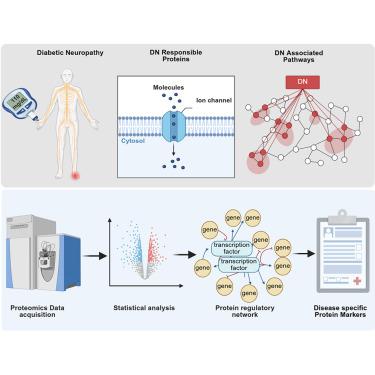糖尿病神经病变的最新进展:蛋白质作为治疗靶点
IF 4.1
2区 综合性期刊
Q1 MULTIDISCIPLINARY SCIENCES
引用次数: 0
摘要
糖尿病性神经病变是一种使人衰弱的糖尿病并发症,其特征是神经损伤,可导致麻木、足部溃疡和截肢,是糖尿病患者发病和死亡的主要原因。除了疼痛管理之外,目前还没有治疗糖尿病神经病变的方法。蛋白质研究的最新进展已经确定了与疾病发展和进展相关的潜在靶点。本文综述了糖尿病神经病变中蛋白质可能作为药物靶点的最新研究及其在多元醇代谢、氧化应激和细胞因子调节等相关过程中的作用。此外,我们还从单细胞和空间分辨率的角度全面介绍了当前的发展和发现,揭示了背根神经节、坐骨神经、三叉神经节或雪旺细胞中不受调节的蛋白质谱。最后,我们讨论了蛋白质组学技术识别蛋白质和相关信号通路的好处,以更好地了解糖尿病神经病变的来源。本文章由计算机程序翻译,如有差异,请以英文原文为准。

Current advances in diabetic neuropathy: Proteins as therapeutic targets
Diabetic neuropathy is a debilitating complication of diabetes characterized by nerve damage that may lead to numbness, foot ulcers, and amputations, and is a major cause of morbidity and mortality in people with diabetes. There are no treatments available for diabetic neuropathy aside from pain management. Recent advances in protein research have identified potential targets associated with the disease development and progression. This review explores the latest studies identifying proteins as possible drug targets in diabetic neuropathy and their role in relevant processes such as polyol metabolism, oxidative stress, and cytokine regulation. Additionally, we provide a comprehensive view of current developments and discoveries at single cell and spatial resolution that have revealed deregulated protein profiles in the dorsal root ganglia, sciatic nerve, trigeminal ganglion, or Schwann cells. Finally, we discuss the benefits of proteomics technologies to identify proteins and associated signaling pathways to better understand the source of diabetic neuropathy.
求助全文
通过发布文献求助,成功后即可免费获取论文全文。
去求助
来源期刊

iScience
Multidisciplinary-Multidisciplinary
CiteScore
7.20
自引率
1.70%
发文量
1972
审稿时长
6 weeks
期刊介绍:
Science has many big remaining questions. To address them, we will need to work collaboratively and across disciplines. The goal of iScience is to help fuel that type of interdisciplinary thinking. iScience is a new open-access journal from Cell Press that provides a platform for original research in the life, physical, and earth sciences. The primary criterion for publication in iScience is a significant contribution to a relevant field combined with robust results and underlying methodology. The advances appearing in iScience include both fundamental and applied investigations across this interdisciplinary range of topic areas. To support transparency in scientific investigation, we are happy to consider replication studies and papers that describe negative results.
We know you want your work to be published quickly and to be widely visible within your community and beyond. With the strong international reputation of Cell Press behind it, publication in iScience will help your work garner the attention and recognition it merits. Like all Cell Press journals, iScience prioritizes rapid publication. Our editorial team pays special attention to high-quality author service and to efficient, clear-cut decisions based on the information available within the manuscript. iScience taps into the expertise across Cell Press journals and selected partners to inform our editorial decisions and help publish your science in a timely and seamless way.
 求助内容:
求助内容: 应助结果提醒方式:
应助结果提醒方式:


